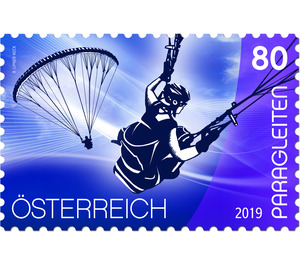Series: Sports - Sport and air - paragliding - Austria / II. Republic of Austria 2019 - 80 Euro Cent
Theme: Sports & Games
| Country | Austria / II. Republic of Austria |
| Issue Date | 2019 |
| Face Value | 80.00 |
| Color | white violet |
| Printing Type | offset |
| Stamp Type | Commemorative |
| Item Type | Stamp |
| SID | 639652 |
| Dimensions | 50.00 x 32.00 |
| In 77 Wishlists | |
The “Sports” series launched in 2018 focuses on both popular and less well-known sports. This year the three stamps from this series are dedicated to sports which are practised at lofty heights. Gliding down from a mountain: The history of paragliding began in the 1940s with research by NASA into parachutes. During the 1960s people experimented with various paraglider wings. Using the wing he designed for himself, David Barish organised demonstrations of “Slope Soaring” in American ski resorts, bringing the sport to the attention of the public for the first time. However, it took until the 1980s for paragliding to become a sport in its own right, starting in the Alpine regions. Initially it was primarily about descending from a mountain to the valley as quickly as possible, but today, thanks to improvements in the materials, techniques and the use of thermals, long flights with significant increases in height and even aerobatic manoeuvres are possible. The equipment: Paragliders have no need of engines or bulky aircraft. All of the equipment, consisting of the wing, the harness, the emergency parachute and a helmet, is stowed in a rucksack and can be transported with ease. The elliptical wing with a surface area of between around 20 and 35 square metres is made of two layers of coated nylon. Suspension lines connect the paraglider wing to the harness, a seat in which the pilot is buckled in by means of straps. The wing is steered using two control lines which are attached to it. Pulling on one of the lines reduces the speed on one side of the wing, enabling the paraglider to make turns; pulling on both reduces the speed over the whole wing. The paraglider wing can independently reach airspeeds of around 30 km/h and can be accelerated to 50 km/h. In Austria, as in many other countries, basic training is required to learn how to paraglide, with safety and a realistic perception of one's own capabilities being paramount. With its “light and airy” design with dynamic colour contrast, the special stamp shows a paraglider in harness as well as a view of the entire apparatus.


